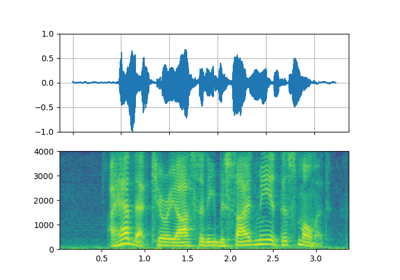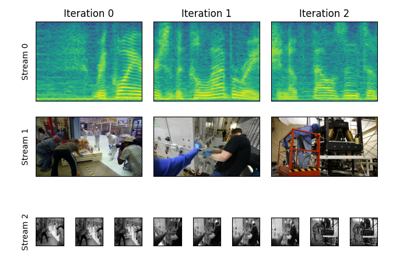StreamReader
- class torchaudio.io.StreamReader(src: str, format: Optional[str] = None, option: Optional[Dict[str, str]] = None, buffer_size: int = 4096)[source]
Fetch and decode audio/video streams chunk by chunk.
For the detailed usage of this class, please refer to the tutorial.
- Parameters:
src (str, file-like object or Tensor) –
The media source. If string-type, it must be a resource indicator that FFmpeg can handle. This includes a file path, URL, device identifier or filter expression. The supported value depends on the FFmpeg found in the system.
If file-like object, it must support read method with the signature read(size: int) -> bytes. Additionally, if the file-like object has seek method, it uses the method when parsing media metadata. This improves the reliability of codec detection. The signagure of seek method must be seek(offset: int, whence: int) -> int.
If Tensor, it is interpreted as byte buffer. It must be one-dimensional, of type
torch.uint8.Please refer to the following for the expected signature and behavior of read and seek method.
format (str or None, optional) –
Override the input format, or specify the source sound device. Default:
None(no override nor device input).This argument serves two different usecases.
Override the source format. This is useful when the input data do not contain a header.
Specify the input source device. This allows to load media stream from hardware devices, such as microphone, camera and screen, or a virtual device.
Note
This option roughly corresponds to
-foption offfmpegcommand. Please refer to the ffmpeg documentations for the possible values.https://ffmpeg.org/ffmpeg-formats.html
For device access, the available values vary based on hardware (AV device) and software configuration (ffmpeg build).
option (dict of str to str, optional) –
Custom option passed when initializing format context (opening source).
You can use this argument to change the input source before it is passed to decoder.
Default:
None.buffer_size (int) –
The internal buffer size in byte. Used only when src is file-like object.
Default: 4096.
- Tutorials using
StreamReader:
Properties
default_audio_stream
- property StreamReader.default_audio_stream
The index of default audio stream.
Noneif there is no audio stream- Type:
Optional[int]
default_video_stream
- property StreamReader.default_video_stream
The index of default video stream.
Noneif there is no video stream- Type:
Optional[int]
num_out_streams
num_src_streams
Methods
add_audio_stream
- StreamReader.add_audio_stream(frames_per_chunk: int, buffer_chunk_size: int = 3, stream_index: Optional[int] = None, decoder: Optional[str] = None, decoder_option: Optional[Dict[str, str]] = None, filter_desc: Optional[str] = None)[source]
Add output audio stream
- Parameters:
frames_per_chunk (int) – Number of frames returned as one chunk. If the source stream is exhausted before enough frames are buffered, then the chunk is returned as-is.
buffer_chunk_size (int, optional) –
Internal buffer size. When the number of chunks buffered exceeds this number, old frames are dropped.
Default:
3.stream_index (int or None, optional) – The source audio stream index. If omitted,
default_audio_streamis used.decoder (str or None, optional) –
The name of the decoder to be used. When provided, use the specified decoder instead of the default one.
To list the available decoders, you can use ffmpeg -decoders command.
Default:
None.decoder_option (dict or None, optional) –
Options passed to decoder. Mapping from str to str.
To list decoder options for a decoder, you can use ffmpeg -h decoder=<DECODER> command.
Default:
None.filter_desc (str or None, optional) – Filter description. The list of available filters can be found at https://ffmpeg.org/ffmpeg-filters.html Note that complex filters are not supported.
add_basic_audio_stream
- StreamReader.add_basic_audio_stream(frames_per_chunk: int, buffer_chunk_size: int = 3, stream_index: Optional[int] = None, decoder: Optional[str] = None, decoder_option: Optional[Dict[str, str]] = None, format: Optional[str] = 'fltp', sample_rate: Optional[int] = None)[source]
Add output audio stream
- Parameters:
frames_per_chunk (int) – Number of frames returned as one chunk. If the source stream is exhausted before enough frames are buffered, then the chunk is returned as-is.
buffer_chunk_size (int, optional) –
Internal buffer size. When the number of chunks buffered exceeds this number, old frames are dropped.
Default:
3.stream_index (int or None, optional) – The source audio stream index. If omitted,
default_audio_streamis used.decoder (str or None, optional) –
The name of the decoder to be used. When provided, use the specified decoder instead of the default one.
To list the available decoders, you can use ffmpeg -decoders command.
Default:
None.decoder_option (dict or None, optional) –
Options passed to decoder. Mapping from str to str.
To list decoder options for a decoder, you can use ffmpeg -h decoder=<DECODER> command.
Default:
None.format (str, optional) –
Output sample format (precision).
If
None, the output chunk has dtype corresponding to the precision of the source audio.Otherwise, the sample is converted and the output dtype is changed as following.
"u8p": The output istorch.uint8type."s16p": The output istorch.int16type."s32p": The output istorch.int32type."s64p": The output istorch.int64type."fltp": The output istorch.float32type."dblp": The output istorch.float64type.
Default:
"fltp".sample_rate (int or None, optional) – If provided, resample the audio.
add_basic_video_stream
- StreamReader.add_basic_video_stream(frames_per_chunk: int, buffer_chunk_size: int = 3, stream_index: Optional[int] = None, decoder: Optional[str] = None, decoder_option: Optional[Dict[str, str]] = None, hw_accel: Optional[str] = None, format: Optional[str] = 'rgb24', frame_rate: Optional[int] = None, width: Optional[int] = None, height: Optional[int] = None)[source]
Add output video stream
- Parameters:
frames_per_chunk (int) – Number of frames returned as one chunk. If the source stream is exhausted before enough frames are buffered, then the chunk is returned as-is.
buffer_chunk_size (int, optional) –
Internal buffer size. When the number of chunks buffered exceeds this number, old frames are dropped.
Default:
3.stream_index (int or None, optional) – The source video stream index. If omitted,
default_video_streamis used.decoder (str or None, optional) –
The name of the decoder to be used. When provided, use the specified decoder instead of the default one.
To list the available decoders, you can use ffmpeg -decoders command.
Default:
None.decoder_option (dict or None, optional) –
Options passed to decoder. Mapping from str to str.
To list decoder options for a decoder, you can use ffmpeg -h decoder=<DECODER> command.
Default:
None.hw_accel (str or None, optional) –
Enable hardware acceleration.
When video is decoded on CUDA hardware, for example decode=”h264_cuvid”, passing CUDA device indicator to hw_accel (i.e. hw_accel=”cuda:0”) will place the resulting frames directly on the specifiec CUDA device.
If None, the frame will be moved to CPU memory. Default:
None.format (str, optional) –
Change the format of image channels. Valid values are,
"rgb24": 8 bits * 3 channels (R, G, B)"bgr24": 8 bits * 3 channels (B, G, R)"yuv420p": 8 bits * 3 channels (Y, U, V)"gray": 8 bits * 1 channels
Default:
"rgb24".frame_rate (int or None, optional) – If provided, change the frame rate.
width (int or None, optional) – If provided, change the image width. Unit: Pixel.
height (int or None, optional) – If provided, change the image height. Unit: Pixel.
add_video_stream
- StreamReader.add_video_stream(frames_per_chunk: int, buffer_chunk_size: int = 3, stream_index: Optional[int] = None, decoder: Optional[str] = None, decoder_option: Optional[Dict[str, str]] = None, hw_accel: Optional[str] = None, filter_desc: Optional[str] = None)[source]
Add output video stream
- Parameters:
frames_per_chunk (int) – Number of frames returned as one chunk. If the source stream is exhausted before enough frames are buffered, then the chunk is returned as-is.
buffer_chunk_size (int, optional) –
Internal buffer size. When the number of chunks buffered exceeds this number, old frames are dropped.
Default:
3.stream_index (int or None, optional) – The source video stream index. If omitted,
default_video_streamis used.decoder (str or None, optional) –
The name of the decoder to be used. When provided, use the specified decoder instead of the default one.
To list the available decoders, you can use ffmpeg -decoders command.
Default:
None.decoder_option (dict or None, optional) –
Options passed to decoder. Mapping from str to str.
To list decoder options for a decoder, you can use ffmpeg -h decoder=<DECODER> command.
Default:
None.hw_accel (str or None, optional) –
Enable hardware acceleration.
When video is decoded on CUDA hardware, for example decode=”h264_cuvid”, passing CUDA device indicator to hw_accel (i.e. hw_accel=”cuda:0”) will place the resulting frames directly on the specifiec CUDA device.
If None, the frame will be moved to CPU memory. Default:
None.filter_desc (str or None, optional) – Filter description. The list of available filters can be found at https://ffmpeg.org/ffmpeg-filters.html Note that complex filters are not supported.
get_metadata
get_out_stream_info
- StreamReader.get_out_stream_info(i: int) StreamReaderOutputStream[source]
Get the metadata of output stream
- Parameters:
i (int) – Stream index.
- Returns:
OutputStream
get_src_stream_info
- StreamReader.get_src_stream_info(i: int) StreamReaderSourceStream[source]
Get the metadata of source stream
- Parameters:
i (int) – Stream index.
- Returns:
SourceStream
is_buffer_ready
pop_chunks
process_all_packets
- StreamReader.process_all_packets()[source]
Process packets until it reaches EOF.
process_packet
- StreamReader.process_packet(timeout: Optional[float] = None, backoff: float = 10.0) int[source]
Read the source media and process one packet.
If a packet is read successfully, then the data in the packet will be decoded and passed to corresponding output stream processors.
If the packet belongs to a source stream that is not connected to an output stream, then the data are discarded.
When the source reaches EOF, then it triggers all the output stream processors to enter drain mode. All the output stream processors flush the pending frames.
- Parameters:
timeout (float or None, optional) –
Timeout in milli seconds.
This argument changes the retry behavior when it failed to process a packet due to the underlying media resource being temporarily unavailable.
When using a media device such as a microphone, there are cases where the underlying buffer is not ready. Calling this function in such case would cause the system to report EAGAIN (resource temporarily unavailable).
>=0: Keep retrying until the given time passes.0<: Keep retrying forever.None: No retrying and raise an exception immediately.
Default:
None.Note
The retry behavior is applicable only when the reason is the unavailable resource. It is not invoked if the reason of failure is other.
backoff (float, optional) –
Time to wait before retrying in milli seconds.
This option is effective only when timeout is effective. (not
None)When timeout is effective, this backoff controls how long the function should wait before retrying. Default:
10.0.
- Returns:
0A packet was processed properly. The caller can keep calling this function to buffer more frames.1The streamer reached EOF. All the output stream processors flushed the pending frames. The caller should stop calling this method.- Return type:
remove_stream
seek
stream
- StreamReader.stream(timeout: Optional[float] = None, backoff: float = 10.0) Iterator[Tuple[Optional[Tensor], ...]][source]
Return an iterator that generates output tensors
- Parameters:
timeout (float or None, optional) – See
process_packet(). (Default:None)backoff (float, optional) – See
process_packet(). (Default:10.0)
- Returns:
Iterator that yields a tuple of chunks that correspond to the output streams defined by client code. If an output stream is exhausted, then the chunk Tensor is substituted with
None. The iterator stops if all the output streams are exhausted.- Return type:
Iterator[Tuple[Optional[torch.Tensor], …]]
Support Structures
StreamReaderSourceStream
- class torchaudio.io.StreamReaderSourceStream[source]
The metadata of a source stream, returned by
get_src_stream_info().This class is used when representing streams of media type other than audio or video.
When source stream is audio or video type,
StreamReaderSourceAudioStreamandStreamReaderSourceVideoStream, which reports additional media-specific attributes, are used respectively.- media_type: str
The type of the stream. One of
"audio","video","data","subtitle","attachment"and empty string.Note
Only audio and video streams are supported for output.
Note
Still images, such as PNG and JPEG formats are reported as video.
- codec: str
Short name of the codec. Such as
"pcm_s16le"and"h264".
- codec_long_name: str
Detailed name of the codec.
Such as “PCM signed 16-bit little-endian” and “H.264 / AVC / MPEG-4 AVC / MPEG-4 part 10”.
- format: Optional[str]
Media format. Such as
"s16"and"yuv420p".Commonly found audio values are;
"u8","u8p": Unsigned 8-bit unsigned interger."s16","s16p": 16-bit signed integer."s32","s32p": 32-bit signed integer."flt","fltp": 32-bit floating-point.
Note
p at the end indicates the format is planar. Channels are grouped together instead of interspersed in memory.
- bit_rate: Optional[int]
Bit rate of the stream in bits-per-second. This is an estimated values based on the initial few frames of the stream. For container formats and variable bit rate, it can be 0.
StreamReaderSourceAudioStream
- class torchaudio.io.StreamReaderSourceAudioStream[source]
The metadata of an audio source stream, returned by
get_src_stream_info().This class is used when representing audio stream.
In addition to the attributes reported by
StreamReaderSourceStream, the following attributes are reported.- sample_rate: float
Sample rate of the audio.
- num_channels: int
Number of channels.
StreamReaderSourceVideoStream
- class torchaudio.io.StreamReaderSourceVideoStream[source]
The metadata of a video source stream, returned by
get_src_stream_info().This class is used when representing video stream.
In addition to the attributes reported by
StreamReaderSourceStream, the following attributes are reported.- width: int
Width of the video frame in pixel.
- height: int
Height of the video frame in pixel.
- frame_rate: float
Frame rate.
StreamReaderOutputStream
- class torchaudio.io.StreamReaderOutputStream[source]
Output stream configured on
StreamReader, returned byget_out_stream_info().- source_index: int
Index of the source stream that this output stream is connected.
- filter_description: str
Description of filter graph applied to the source stream.





